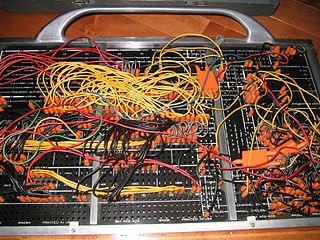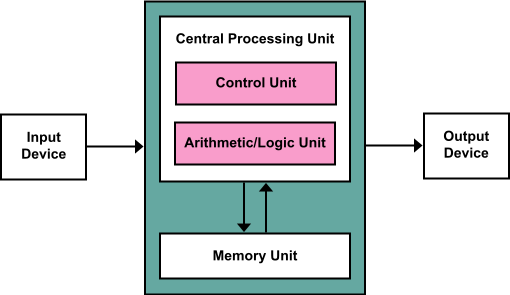Original Harvard architecture
 Source
Instruction code and data 'stored' in separate mechanisms and
accessed with dedicated circuitry and buses.
Access to both can occur at the same time (parallelism - faster).
Program memory - read only during execution.
Program 'byte' and data 'byte' could be different sizes.
Separate instructions for accessing code memory and data memory.
Original computer architecture.
System was programmed by physically wiring the circuits to
perform desired algorithm.
Source
Instruction code and data 'stored' in separate mechanisms and
accessed with dedicated circuitry and buses.
Access to both can occur at the same time (parallelism - faster).
Program memory - read only during execution.
Program 'byte' and data 'byte' could be different sizes.
Separate instructions for accessing code memory and data memory.
Original computer architecture.
System was programmed by physically wiring the circuits to
perform desired algorithm.
 wikipedia : plugboard
Data was often provided as punched cards or some other physical
media and mechanically read.
Required manual programming and start-up.
The operator was the 'operating system'.
Difficult/impossible to re-assign resources, such as memory, between
code area and data area.
Advantage
Faster execution.
Parallel, concurrent access to code and data memory.
Disadvantage
Not able to 'borrow' unused memory from other's area.
Needs circuitry that is redundant.
wikipedia : plugboard
Data was often provided as punched cards or some other physical
media and mechanically read.
Required manual programming and start-up.
The operator was the 'operating system'.
Difficult/impossible to re-assign resources, such as memory, between
code area and data area.
Advantage
Faster execution.
Parallel, concurrent access to code and data memory.
Disadvantage
Not able to 'borrow' unused memory from other's area.
Needs circuitry that is redundant.
von Neumann system or stored-program architecture.
 Source
(John von Neumann, John Mauchly, J. Preser Eckert) 1940's
Both data and instructions stored in a common area. (Stored program).
Distinction between instruction and program data contextually recognized.
Instructions are sequentially read and executed using a program counter
(or instruction pointer) to keep track of next instruction to be executed.
Single path for all activity.
Arbitrarily reassign resources, such as memory, between code and data
as needed.
Inexpensive hardware design, very flexible, (speed suffers).
* von Neumann bottleneck
Because both program and data access occurred over the same path,
only one of these can be happening at any moment.
Fetch/store instruction agnostic to type of information being moved.
Advantage - optimal use of expensive memory.
Easy to allocate more memory for either program (loading subroutines)
or data, either at load time or during execution.
Disadvantage - can access either code or data, but not both at same time.
Tends to slow execution of code.
von Neumann architecture hardware :
Processing unit.
ALU - arithmetic logic unit and work registers for holding data
and results.
Control unit holding instruction register and program counter.
Sequences through program instructions, decodes, and controls
execution of program.
I/O mechanism and interface - registers/logic for moving data and
instruction into and out of CPU.
Local memory holding both code to be executed and data to be processed
and data results.
Connected together to create an architecture called the data path.
Simple single path between memory and the computation unit of the CPU.
This is what a program "sees" when it is running.
Program execution consists of
Sequential instruction processing.
Fetch instruction from memory (addressed by instruction pointer).
Adjust instruction pointer (program counter) to next instruction.
Most modern CPUs adjust instruction pointer concurrent with next
step.
Interpret instruction.
Execute instruction (may involve fetching/writing data from/to memory).
Repeat
Advantage - simple and flexible hardware design.
Simple internal shared bus to move instruction and data around
internally.
Freedom to allot needed memory at both load and run-time
for either program or data.
Disadvantage - von Neumann bottleneck.
Each instruction must be completed before next instruction retrieved.
Only code or only data can use internal bus or certain circuits at
a particular moment.
Other circuits may sit idle.
* Allows self-modifying code
No longer considered an advantage. Hard to debug.
Although just-in-time compilation useful.
Source
(John von Neumann, John Mauchly, J. Preser Eckert) 1940's
Both data and instructions stored in a common area. (Stored program).
Distinction between instruction and program data contextually recognized.
Instructions are sequentially read and executed using a program counter
(or instruction pointer) to keep track of next instruction to be executed.
Single path for all activity.
Arbitrarily reassign resources, such as memory, between code and data
as needed.
Inexpensive hardware design, very flexible, (speed suffers).
* von Neumann bottleneck
Because both program and data access occurred over the same path,
only one of these can be happening at any moment.
Fetch/store instruction agnostic to type of information being moved.
Advantage - optimal use of expensive memory.
Easy to allocate more memory for either program (loading subroutines)
or data, either at load time or during execution.
Disadvantage - can access either code or data, but not both at same time.
Tends to slow execution of code.
von Neumann architecture hardware :
Processing unit.
ALU - arithmetic logic unit and work registers for holding data
and results.
Control unit holding instruction register and program counter.
Sequences through program instructions, decodes, and controls
execution of program.
I/O mechanism and interface - registers/logic for moving data and
instruction into and out of CPU.
Local memory holding both code to be executed and data to be processed
and data results.
Connected together to create an architecture called the data path.
Simple single path between memory and the computation unit of the CPU.
This is what a program "sees" when it is running.
Program execution consists of
Sequential instruction processing.
Fetch instruction from memory (addressed by instruction pointer).
Adjust instruction pointer (program counter) to next instruction.
Most modern CPUs adjust instruction pointer concurrent with next
step.
Interpret instruction.
Execute instruction (may involve fetching/writing data from/to memory).
Repeat
Advantage - simple and flexible hardware design.
Simple internal shared bus to move instruction and data around
internally.
Freedom to allot needed memory at both load and run-time
for either program or data.
Disadvantage - von Neumann bottleneck.
Each instruction must be completed before next instruction retrieved.
Only code or only data can use internal bus or certain circuits at
a particular moment.
Other circuits may sit idle.
* Allows self-modifying code
No longer considered an advantage. Hard to debug.
Although just-in-time compilation useful.
Most modern systems use a variety of techniques for optimizing or working around the von Neumann bottleneck. Micro-controllers (CPUs designed for specific tasks). Fast, economical, Harvard architecture, program code flashed in ROM. Inexpensive calculators are usually Harvard architecture. * Usually have limited functionality. Modified Harvard architecture. Memory closest to CPU has separate caches for code and memory. Separate internal paths for code and data between closest cache (level 1) and CPU core.